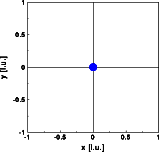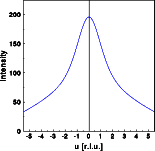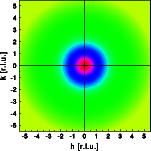Basic example I: Single atom

Basic examples
Single atom
Pair of atoms
Row of atoms
Interactive examples
1D crystal builder
Polygons of atoms
Different atoms
Ewald sphere
Units
Interference
Bragg's law
Goto
Contents
In this first example we calculate the Fourier transform of a single silicon atom. The scattering factors for X-rays are used. The atom is shown schematically as a disk. Later examples show the actual electron density distribution. The pictures below show the single atom and the corresponding 1D and 2D Fourier transform. Remember that you can get a full screen version of the pictures by clicking on them.



The middle image shows a one dimensional cut through the center of reciprocal space. You can see that the intensity drops off continuously with increasing scattering vector. This is caused by the finite size of the electron density distribution at the atom. The right image shows a 2-dimensional section through reciprocal space. As depicted by the read and purple colors the intensity is highest at the origin of reciprocal space. The Fourier transform of a single atom has spherical symmetry corresponding to the spherical symmetry of the electron density distribution.